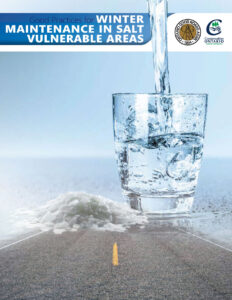
Cover of Good Practices for Winter Maintenance
This is a 4 MB (large) PDF file of the report Good Practices for Winter Maintenance in Salt Vulnerable Areas. June 2018. Ontario Good Roads Association, Conservation Ontario.
Good Practices for Winter Maintenance in Salt Vulnerable Areas
This guidance document serves as a resource on environmental best management practices for organizations managing road salt, where it is used for road maintenance purposes during the winter season, as the dates are locally designated. It is developed by a multi-stakeholder ‘Salt Vulnerable Areas’ working group comprised of members from municipal organizations, conservation authorities, as well as provincial and federal governments.
This guidance is a living document to help address the impacts of road salt, within specific vulnerable areas, and will be reviewed every two years to remain current with technological and legislative changes. There are several types of ‘salt vulnerable areas’, with various environment and human health goals including drinking water quality, wetland health, and fisheries. This document currently prioritizes certain areas where municipal drinking water sources are known to be impacted by road salt. These areas are ‘Issue Contributing Areas’ specific to sodium and chloride, delineated under the Ontario Clean Water Act, 2006.
There are several practices implemented by municipalities in Ontario to help mitigate the long-term effects of road salt on surface water and groundwater. These practices are offered as ‘good practices’ for other municipalities to adopt if Issue Contributing Areas have been delineated around municipal drinking water systems as a result of increased sodium and/or chloride concentrations. While the intent of this document is to provide guidance to municipalities in the interest of protecting municipal sources of drinking water, in all instances, the protection of the travelling public must be paramount in selecting the most appropriate operational practice for local road authorities to adopt.
The content of this document was developed by a working group comprised of representatives of the Ontario Good Roads Association, Conservation Ontario, the Province of Ontario, and the Government of Canada, and represents a compendium of good practices for municipal winter maintenance in Ontario at the time of publication. Neither the members of the working group nor the parent organizations warrant or certify this information and assume no responsibility for the accuracy of the information or any harm to persons or property as a result of road agencies adopting or modifying the maintenance practices described in this document.
Download now:



